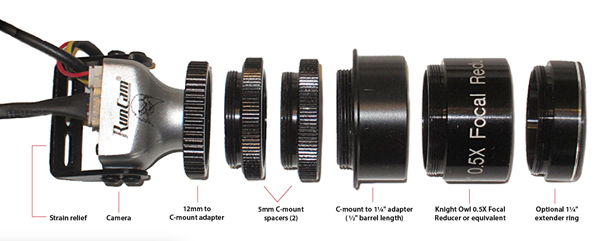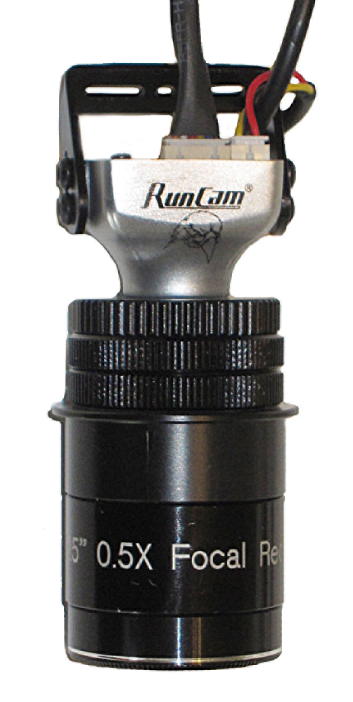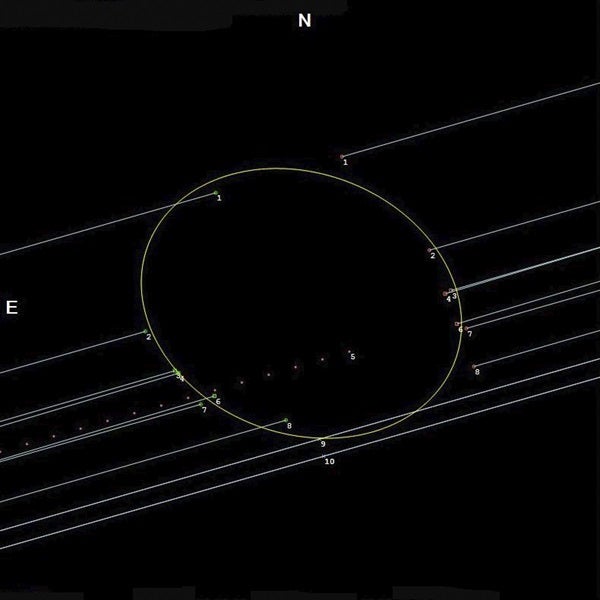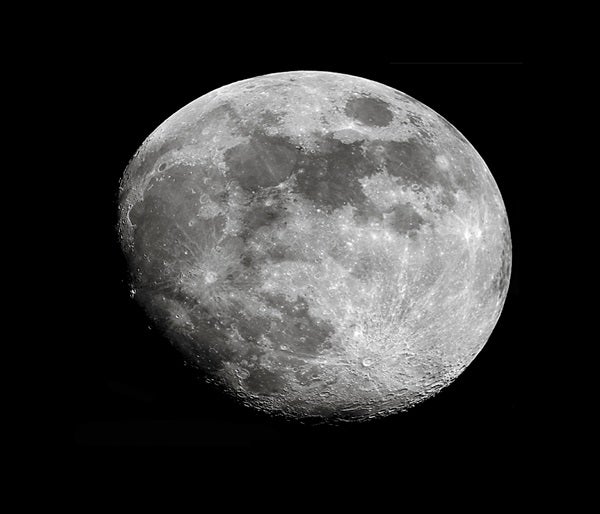The monochrome RunCam Night Eagle 2 Astro Edition has a sensitivity of 0.00001 lux and supports the 640×480 NTSC and 720×576 PAL formats. Using CMOS technology, its sensor can detect faint stellar targets even through small portable telescopes.
IOTA has assisted RunCam to produce an incredible video camera at an affordable price. Enhancements made specifically to aid in the observation of occultations include internally controlled integrations of two, four, and eight exposures (providing images of stars across the field of view well into the double-digit magnitude range); improved gain controls for faint objects (which now include settings from 1 to 9); and brightness controls for bright objects (which now include settings from 8 to 250). This gives the user maximum control over video exposures.
An added bonus for star party users is that RunCam includes a digital zoom so others can get a close-up view of objects on the video screen.
Of course, your field of view through different optical configurations will vary. When using the 0.5 Knight Owl Focal Reducer without the zoom, a 12-inch f/5 Newtonian reflector produces a field 0.5° wide, or equal to the width of the Full Moon. A 4.8-inch f/5 refractor gives a field twice as wide, a full 1°. And wider (even much wider) fields are possible through camera lenses of various focal lengths.
Because of the camera’s sensitivity, bright planets can saturate the sensor when using the Knight Owl 0.5 Focal Reducer. However, I am confident that those interested in planetary photography will find little difficulty in replacing the Knight Owl Focal Reducer with a quality Barlow lens to double or triple the system’s focal length, making the planets much more viewable.
RunCam produces and sells the Night Eagle 2 on its own. The Night Eagle 2 Astro Edition, which contains the aforementioned enhancements, is available only through IOTA. That organization offers three different kits. For $79 plus shipping, you’ll receive just the camera with a wide-angle lens. For $149 plus shipping, you get the camera, plus all accessories (M12 to C adapter, 5mm spacer rings, camera C-mount to 1¼” adapter) except the 0.5x focal reducer. IOTA includes the Knight Owl 0.5 Focal Reducer and everything else for $179 plus shipping.
In the pictures of the camera’s components, you can see a black bracket attached to it. While the company designed this bracket for mounting the camera in quadcopters (an environment where there would be little or no stray light), users found that the mounting holes let in light that can impinge on the sensor. So, I recommend attaching this bracket both to seal out stray light and to relieve strain on the delicate power and video cables.
Even with the bracket holes sealed, though, some light can get in around the edges of the camera case. For advice for dealing with this issue, visit IOTA’s website: http://occultations.org/documents/AstroMetalTapeLightLeakSolution.pdf.
You can record the camera’s output directly onto a small portable video camera (like the Canon ZR or Elura series, which both use DV tape and little compression), a full-size VCR recorder, or a computer hard drive. For computer capture, a USB 3.0 port and a frame grabber (like the StarTech SVID2USB23) are required. IOTA does not recommend using small portable digital video recorders because they compress the images to a point where their scientific value is degraded.
You can download for free all the software offered by IOTA members in support of occultation recording. You’ll find it at www.asteroidoccultation.com/observations. Most useful to the beginner will probably be the IOTA Video Capture program, which allows a Windows computer to capture the video stream and convert it to an AVI file for later analysis. Further down on the webpage, you’ll find the link to a dedicated YouTube channel that contains examples of RunCam Night Eagle 2 Astro Edition videos and images.
In occultation work, accurate timing of the disappearance and reappearance of a star is extremely important. To help you out, IOTA has developed the IOTA-VTI v3 video time inserter, which you’ll find at http://videotimers.com/home.html.
This small, battery-powered device contains a GPS antenna and adds a time stamp (accurate to milliseconds) to the bottom of every frame of your occultation video. It also allows you to record the exact location at which you made the observation.
Recording stellar occultations allows amateur astronomers to make real scientific contributions to the study of the solar system, double stars, and more. The combination of the RunCam Night Eagle 2 Astro Camera and the IOTA-VTI v3 offers an inexpensive way to get into this exciting branch of citizen science.














